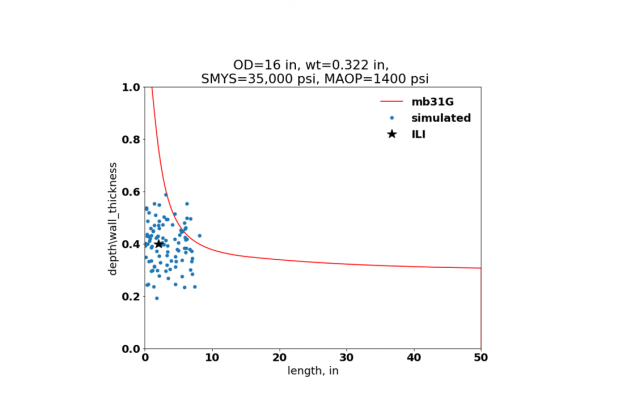One Bridge Solutions
A Risk Approach to Managing Remaining Anomalies
Overview
Inline Inspection tools are one of the technologies used to assess the integrity state of pipelines. Different tools exist, based on physical principles, which can help identify locations where the pipe wall may have flaws that can lead to a critical state. However, due to potential inaccuracies in data collection and reporting tool vendors provide additional information about the tolerances and thresholds of the tool readings. This additional information can be used to determine the potential state of given anomalies and just how close to a critical scenario they may be, typically using a burst model. In this analysis, we consider the ASME modified B31G burst model, which uses the flaw length and depth, pipe properties and maximum operating pressure to predict pipe failure.
The Probability of Exceedance (PoE) calculation helps integrity engineers carry-out a complete analysis of the possible state of the pipeline in between inspection cycles. In this video, Michael Gloven, President of Pipeline-Risk, discusses how the PoE calculation is completed within Cognitive Integrity Management (CIM).
Cognitive Integrity Management calculates the PoE of each existing metal loss anomaly. The result is expressed as a probability between 0 and 100%, where 0% means no chance of failure according to the burst model, and 100% implies that the flaw under every consideration will fail according to the burst model. In addition to this, the PoE can be combined with the consequence of failure, for the calculation of risk of failure.
Methodology
Using the maximum allowable operating pressure (MAOP) in addition to the pipe properties of diameter, wall thickness, and SMYS, the burst curve can be calculated for all depths between zero and the wall thickness using the modified B31G model.
Flaw length and depth are treated as continuous probability distributions according to the tolerances specified by the tool vendor. The figure below shows a random sample of 100 of these values distributed around the ILI-reported length and depth calls, as well as the modelled burst curve.

The results for this example case show that the PoE is 0.1475. This implies that although the tool reading suggests that the flaw is in the safe operating zone, due to the uncertainties in the tool reading there is a 14.75% chance that the anomaly is actually within the critical zone. This information can be used by the Pipeline Integrity Engineer to plan for maintenance of the asset.
OneBridge Solutions, Inc. has developed an optimized algorithm to accurately compute PoE as part of the CIM Integrity Compliance analysis business process.
Conclusion
The value that the PoE calculation provides is a consistent approach for evaluating metal loss anomalies and in managing risk. This helps support the prioritization scheduling of future inspections and potential mitigations and can be done in real-time inside Cognitive Integrity Management. The PoE calculation can help the Pipeline Integrity Engineer do a more complete analysis of the possible state of the pipe, thanks to the inclusion of the uncertainties derived from the Inline Inspection tool.


















